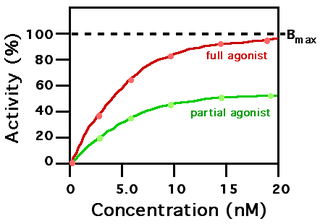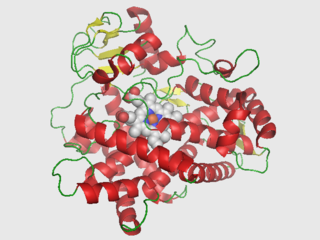
Ampicillin is an antibiotic used to prevent and treat a number of bacterial infections, such as respiratory tract infections, urinary tract infections, meningitis, salmonellosis, and endocarditis. It may also be used to prevent group B streptococcal infection in newborns. It is used by mouth, by injection into a muscle, or intravenously. Like all antibiotics, it is not useful for the treatment of viral infections.

In particle physics, the weak interaction, which is also often called the weak force or weak nuclear force, is the mechanism of interaction between subatomic particles that is responsible for the radioactive decay of atoms. The weak interaction serves an essential role in nuclear fission, and the theory regarding it in terms of both its behavior and effects is sometimes called quantum flavordynamics (QFD). However, the term QFD is rarely used because the weak force is better understood in terms of electroweak theory (EWT). In addition to this, QFD is related to quantum chromodynamics (QCD), which deals with the strong interaction, and quantum electrodynamics (QED), which deals with the electromagnetic force.

Propranolol, sold under the brand name Inderal among others, is a medication of the beta blocker class. It is used to treat high blood pressure, a number of types of irregular heart rate, thyrotoxicosis, capillary hemangiomas, performance anxiety, and essential tremors. It is used to prevent migraine headaches, and to prevent further heart problems in those with angina or previous heart attacks. It can be taken by mouth or by injection into a vein. The formulation that is taken by mouth comes in short-acting and long-acting versions. Propranolol appears in the blood after 30 minutes and has a maximum effect between 60 and 90 minutes when taken by mouth.

Interaction is a kind of action that occur as two or more objects have an effect upon one another. The idea of a two-way effect is essential in the concept of interaction, as opposed to a one-way causal effect. A closely related term is interconnectivity, which deals with the interactions of interactions within systems: combinations of many simple interactions can lead to surprising emergent phenomena. Interaction has different tailored meanings in various sciences. Changes can also involve interaction.

Nadolol, sold under the brand name Corgard among others, is a medication used to treat high blood pressure, heart pain, and atrial fibrillation. It has also been used to prevent migraine headaches and complications of cirrhosis. It is taken by mouth.
A drug interaction is a change in the action or side effects of a drug caused by concomitant administration with a food, beverage, supplement, or another drug.

Sympathomimetic drugs are stimulant compounds which mimic the effects of endogenous agonists of the sympathetic nervous system. The primary endogenous agonists of the sympathetic nervous system are the catecholamines, which function as both neurotransmitters and hormones. Sympathomimetic drugs are used to treat cardiac arrest and low blood pressure, or even delay premature labor, among other things.

Tazobactam is a pharmaceutical drug that inhibits the action of bacterial β-lactamases, especially those belonging to the SHV-1 and TEM groups. It is commonly used as its sodium salt, tazobactam sodium. In simple terms, it is an ingredient that can be added to certain antibiotics to make them less vulnerable to bacteria's antimicrobial resistance.

Isoprenaline, or isoproterenol, is a medication used for the treatment of bradycardia, heart block, and rarely for asthma. It is a non-selective β adrenoreceptor agonist that is the isopropylamine analog of epinephrine (adrenaline).

Bisoprolol, marketed under the tradename Zebeta among others, is a medication most commonly used for heart diseases. This specifically includes high blood pressure, chest pain from not enough blood flow to the heart, and heart failure. It is taken by mouth.

Dicloxacillin is a narrow-spectrum β-lactam antibiotic of the penicillin class. It is used to treat infections caused by susceptible (non-resistant) Gram-positive bacteria. It is active against beta-lactamase-producing organisms such as Staphylococcus aureus, which would otherwise be resistant to most penicillins. Dicloxacillin is available under a variety of trade names including Diclocil (BMS).

Nebivolol is a beta blocker used to treat high blood pressure and heart failure. As with other β-blockers, it is generally a less preferred treatment for high blood pressure. It may be used by itself or with other blood pressure medication. It is taken by mouth.

Cefoxitin is a second-generation cephamycin antibiotic developed by Merck & Co., Inc. from Cephamycin C in the year following its discovery, 1972. It was synthesized in order to create an antibiotic with a broader spectrum. It is often grouped with the second-generation cephalosporins. Cefoxitin requires a prescription and as of 2010 is sold under the brand name Mefoxin by Bioniche Pharma, LLC. The generic version of Mefoxin is known as cefoxitin sodium.

Loreclezole is a sedative and an anticonvulsant which acts as a GABAA receptor positive allosteric modulator. The binding site of loreclezole has been shown experimentally to be shared by valerenic acid, an extract of the root of the valerian plant. Structurally, loreclezole is a triazole derivative. In animal seizure models, loreclezole is protective against pentylenetetrazol seizures but is less active in the maximal electroshock test. In addition, at low, nontoxic doses, the drug has anti-absence activity in a genetic model of generalized absence epilepsy. Consequently, loreclezole has a profile of activity similar to that of benzodiazepines. A potential benzodiazepine-like interaction with GABA receptors is suggested by the observation that the anticonvulsant effects of loreclezole can be reversed by benzodiazepine receptor inverse agonists. The benzodiazepine antagonist flumazenil, however, fails to alter the anticonvulsant activity of loreclezole, indicating that loreclezole is not a benzodiazepine receptor agonist. Using native rat and cloned human GABA-A receptors, loreclezole strongly potentiated GABA-activated chloride current. However, activity of the drug did not require the presence of the γ-subunit and was not blocked by flumazenil, confirming that loreclezole does not interact with the benzodiazepine recognition site.

ZK-93426 (ethyl-5-isopropoxy-4-methyl-beta-carboline-3-carboxylate) is a drug from the beta-carboline family. It acts as a weak partial inverse agonist of benzodiazepine receptors, meaning that it causes the opposite effects to the benzodiazepine class of drugs and has anxiogenic properties, although unlike most benzodiazepine antagonists it is not a convulsant and actually has weak anticonvulsant effects. In human tests it produced alertness, restlessness and feelings of apprehension, and reversed the effect of the benzodiazepine lormetazepam. It was also shown to produce nootropic effects and increased release of acetylcholine.
Adimolol (MEN-935) is antihypertensive agent which acts as a non-selective α1-, α2-, and β-adrenergic receptor antagonist.

Levomethadone, or levamethadone, is a synthetic opioid analgesic and antitussive which is marketed in Europe and is used for pain management and in opioid maintenance therapy. In addition to being used as a pharmaceutical drug itself, levomethadone, or R-(−)-methadone, is the active enantiomer of methadone, having approximately 50x the potency of the S-(+)-enantiomer as well as greater μ-opioid receptor selectivity. Accordingly, it is about twice as potent as methadone by weight and its effects are virtually identical in comparison. In addition to its activity at the opioid receptors, levomethadone has been found to act as a weak competitive antagonist of the N-methyl-D-aspartate (NMDA) receptor complex and as a potent noncompetitive antagonist of the α3β4 nicotinic acetylcholine (nACh) receptor.

Bunitrolol is a beta-adrenergic antagonist.

Butidrine (INN), or butedrine or butydrine, also known as hydrobutamine or idrobutamine, is a beta blocker related to pronethalol and propranolol that was developed in the 1960s. Similarly to certain other beta blockers, butidrine also possesses local anesthetic properties.

Ceftolozane/tazobactam (TOL-TAZ), sold under the brand name Zerbaxa, is a combination antibiotic. It is used for the treatment of complicated urinary tract infections and complicated intra abdominal infections. Ceftolozane is a cephalosporin antibiotic, developed for the treatment of infections with gram-negative bacteria that have become resistant to conventional antibiotics. It was studied for urinary tract infections, intra-abdominal infections and ventilator-associated bacterial pneumonia.






















